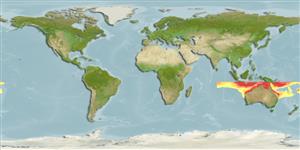Elasmobranchii (tubarões e raias) (sharks and rays) >
Carcharhiniformes (Ground sharks) >
Carcharhinidae (Requiem sharks)
Etymology: Rhizoprionodon: rhiza (Gr.), root; prion (Gr.) saw; odon (Gr.), tooth, referring to teeth with serrated (saw-like) bases, or roots [replacement name for Rhizoprion Ogilby 1915, preoccupied by Rhizoprion Jourdan 1861 in mammals]. (See ETYFish); taylori: In honor of entomologist Frank Henry Taylor (1886-1945), Institute of Tropical Medicine, Townsville, North Queensland, Australia, who collected holotype. (See ETYFish).
More on author: Ogilby.
Environment: milieu / climate zone / depth range / distribution range
Ecologia
marinhas; intervalo de profundidade ? - 300 m (Ref. 75154). Tropical; 8°S - 28°S
Western Pacific: off Papua New Guinea and northern Australia.
Length at first maturity / Tamanho / Peso / Idade
Maturity: Lm 47.0, range 42 - ? cm
Max length : 69.1 cm TL macho/indeterminado; (Ref. 9161); Idade máx. registada: 7 anos (Ref. 9161)
Espinhos dorsais (total): 0; Raios dorsais moles (total): 0; Espinhos anais 0; Raios anais moles: 0. Brownish grey above, white below, fins light-edged but not conspicuously marked (Ref. 9997).
A little-known shark (Ref. 9997) found on the continental shelf from close inshore to a depth of at least 110 m (Ref. 6871). Feeds mainly on fishes, but also takes cephalopods and crustaceans (Ref. 6871). Viviparous (Ref. 50449). Caught frequently by inshore demersal gillnet fisheries off Papua, but rarely elsewhere. Utilized for its fins and meat (Ref.58048). Too small to be of any commercial importance (Ref. 6871).
Viviparous, with a yolk-sac placenta (Ref. 9997) and 1-10 pups after a gestation period of 11-12 months; born at ~ 25 cm TL; very rapid growth (Ref.58048). Distinct pairing with embrace (Ref. 205).
Compagno, L.J.V., 1984. FAO Species Catalogue. Vol. 4. Sharks of the world. An annotated and illustrated catalogue of shark species known to date. Part 2 - Carcharhiniformes. FAO Fish. Synop. 125(4/2):251-655. Rome: FAO. (Ref. 244)
Categoria na Lista Vermelha da IUCN (Ref. 130435)
Ameaça para o homem
Harmless
Utilização humana
Mais informação
ReferênciasAquaculturaPerfil para aquaculturaEstirpesGenéticaElectrophoresesHereditariedadeDoençasProcessamentoNutrientsMass conversion
ColaboradoresFotografiasStamps, Coins Misc.SonsCiguateraVelocidadeTipo de nataçãoÁrea branquialOutras referênciasCérebrosVisão
Ferramentas
Relatórios especiais
Descarregue XML
Fontes da internet
Estimates based on models
Preferred temperature (Ref.
123201): 22.5 - 28, mean 26.6 °C (based on 321 cells).
Phylogenetic diversity index (Ref.
82804): PD
50 = 0.5078 [Uniqueness, from 0.5 = low to 2.0 = high].
Bayesian length-weight: a=0.00427 (0.00199 - 0.00915), b=3.11 (2.94 - 3.28), in cm total length, based on LWR estimates for this Genus-body shape (Ref.
93245).
Nível Trófico (Ref.
69278): 4.5 ±0.0 se; based on diet studies.
Generation time: 2.6 ( na - na) years. Estimated as median ln(3)/K based on 2
growth studies.
Resiliência (Ref.
120179): Muito baixo, tempo mínimo de duplicação da população maior que 14 anos (K=1.01-1.34; tm=1; tmax=7; Fec=1-8).
Fishing Vulnerability (Ref.
59153): Low to moderate vulnerability (33 of 100).
